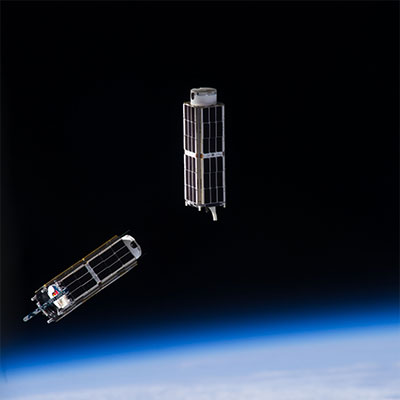Aerospace R&D has been a driving force for innovation pushing major technological advancements that have redefined transportation, led to incredible discoveries, and sheparded in a fourth industrial revolution—digital transformation—which will create exciting opportunities for revolutionary transitions. AIAA can provide thought leadership and be a trusted voice, guiding the larger community through this shift. Interdisciplinary work fostered by advanced collaboration promises to yield breakthroughs in aeronautics and aerospace systems. Digital transformation is driving model-based technological advances such as digital engineering, digital twin, and digital thread, which are expected to accelerate the pace of R&D to deployment of advanced systems significantly. Such innovation can lower overall total lifecycle cost and ultimately improve customer experiences.
Across aeronautics and aerospace, we are information rich, but knowledge poor. We need smarter collaboration between people and their machines and tools to harvest the data. Digital transformation will allow us to capture knowledge, use it in models, and then apply it to new materials. Rapid prototyping and integration will accelerate first-design feasibility. We also need to enable artificial intelligence and machine learning to make our machines smarter. Shifting routine tasks to machines will allow our workforce to focus on tackling the next generation of technology challenges.
Within the Aerospace R&D Domain, we must address significant issues including potential cyberattacks on aerospace systems and building autonomous systems from a moral, ethical, and legal perspective. We also must find ways to accelerate the deployment of technology, with appropriate testing to help ensure success.
Key Topics
 Advanced
Manufacturing and Advanced Materials
Advanced
Manufacturing and Advanced MaterialsHow do we incorporate multifunctional materials, create lighter systems through the application of new materials and new manufacturing techniques, and accelerate the certification of new materials and new manufacturing processes?
 Autonomy
AutonomyWe must safely insert advanced information technologies into aerospace systems and provide smart contingency management capabilities across all aerospace plattorms. How can we leverage lessons from the automotive industry to help us address emerging issues, such as increasing congestion in both air and space traffic? We should consider how we adopt a human-centered autonomy approach.
 Artificial Intelligence/Machine Learning
Artificial Intelligence/Machine Learning
Recent developments in artificial intelligence and machine learning are making headlines, and are already having a strong impact on how aerospace professionals work. How will Al and ML impact aerospace science and engineering practices? How can Al and ML applications provide new pathways for safer, faster, and more cost-effective aerospace system development?
 Resilient and Assured
Systems
Resilient and Assured
Systems
With increasing levels of autonomous control, how do we ensure that the resulting behaviors satisfy legal, moral, and ethical perspectives? As we create increasingly more complex and adaptive systems, how do we ensure that these systems are as safe, or safer, than previous generations? How do we accelerate lessons learned and incorporate into already deployed systems? As systems become more self-aware, can they adapt their control systems to reflect sensor or mechanical disruptions?
 Transformative Systems Engineering
Transformative Systems EngineeringHow do we embrace digital twin concepts being inspired by engineered resilient systems and accelerate adoption of model-based systems engineering (MBSE)? How do we create frameworks to incorporate new technologies into system engineering methodologies, such as human-AI teaming and advanced materials more effectively? And we must leverage new digital techniques to reverse the trend of increasing timelines from first flight to initial operational capability.
Learn More
AIAA Related Content
EVENTS
-
 2024 SmallSat Education Conference
2024 SmallSat Education Conference
26 October - 27 October 2024
Kennedy Space Center Visitors Center, Florida, USA
Join us 26–27 October for the 2024 SmallSat Education Conference, an important East Coast gathering where educators, administrators, and students will learn about CubeSats, ThinSats, and High Altitude Balloon programs. -
 AIAA Young Professionals, Students, and Educators (YPSE) Conference
AIAA Young Professionals, Students, and Educators (YPSE) Conference
22 November 2024
Laurel, Maryland, USA
The AIAA Mid-Atlantic Section is organizing the AIAA Young Professionals, Students, and Educators (YPSE) Conference, to be held 22 November The conference will be held at the Johns Hopkins University Applied Physics Laboratory Kossiakoff Center.
COURSES
-
Composite Structures: Process Analysis, Progressive Damage, Failure Analysis, and Advanced Software
-
The Anatomy of Autonomy
-
Financial and Business Acumen for Navigating the Aerospace Industry
-
Wind Tunnel Testing for Aircraft Development – Online Short Course (Starts 4 March 2025)
4 March - 20 March 2025
This course is a primer on wind tunnels and wind tunnel testing, primarily for aviation applications. The course considers these aspects from both the client side and the facility side, underpinned by a focus on cost and data quality.
Open for registration. Register Now
-
Essential Model-Based Systems Engineering
-
Complex Systems Competency
-
AI for Air Traffic Safety Enhancement
-
Business Development for Aerospace Professionals – Online Short Course (Starts 11 February 2025)
11 February - 20 February 2025
This course is ideal for aerospace technical and scientific people transitioning to new business roles with responsibility for generating and growing sales.
Open for registration. Register Now
NEWS
-
 AIAA to Recognize Excellence with Awards at the 2024 AIAA AVIATION Forum
AIAA to Recognize Excellence with Awards at the 2024 AIAA AVIATION Forum
17 June 2024
AIAA is pleased to announce the winners of technical and management excellence awards to be presented during the 2024 AIAA AVIATION Forum, 29 July – 2 August, Caesars Forum, Las Vegas. Registration is open for the worldwide aviation community to attend. Journalists who wish to cover the forum can request a Press Pass here.


